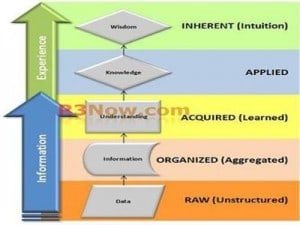When I was at Grant Thornton in the late 1990’s, and then later when the management consulting organization was sold to Hitachi, I worked on a comprehensive knowledge management model (which I will refer to later in this article). The model can be applied to integrating collaboration tools into any enterprise application.
Carefully structured and planned integration of collaboration tools can produce great results. However, integration is a challenge. Many social media types aim to tie collaboration into the business technology for productive use in the enterprise, but few of them have any idea how to do this. Clearly, there is a lot of hype around “Web 2.0” interactive functionality, but little in the way of productive business use.
By moving outside of the enterprise walls to integrate customer interaction and the extended supply chain the enterprise can gain valuable insight. By using structured data gathering and organization techniques business value can be achieved.
In this post, we will look at a few approaches I have taken over the years that have effectively created dynamic collaborative organizations. They don not use Facebook, Twitter, or other marketplace channels, but they do leverage the collaboration concept. Maybe someone can create a use model for social media outlets such as Facebook or Twitter combined with enterprise applications.
Why Enterprise Collaboration Tools Have Not Yet Taken Off
Too many organizations undertake the introduction of social media without a strategic need. In the Knowledge Management area, this is like having information without any context of how to apply that information or the experience to apply it properly. Information alone is not knowledge, and social media or collaboration tools that do not have a specific business purpose are not very productive (if at all). Without a specific context to apply social media tools, they are more likely to be a distraction (see Social Media Fads and the Risk to the Enterprise ).
Facebook and Twitter may not fit in your enterprise. They might provide good advertising channels; however, capturing employee, customer, and vendor knowledge; suggestions; or criticisms and then publishing this internally to the right people directly affects your business.
Few social media gurus know how to start this type of structured information gathering dialog from an unstructured information source (see the graphic below). There are few methods, and even fewer tools, to filter through all of the noise from social media tools to find what is meaningful.
What are the social media guru responses? “You don’t understand social media. It is all about building relationships. You haven’t spent enough time. You can’t apply old business rules.” Etc., etc., etc…. All you get are excuses.
Why Consultants and Collaboration Evangelists Have Not Shown Much Progress
Few consultants or businesses have learned how to use social media to drive business value. Businesses rarely find a coherent or even minimally functional method through collaboration or social media tools that affects a company’s key value propositions. Beyond things such as video conferencing and webinars, which reduce expenses related to travel and coordination, not much has been done to move social interaction and collaboration in business to the next level.
The real issue is to use social or collaboration tools in the enterprise for something beyond collaboration. They must serve a business purpose and a business need. The business enterprise is not a social club, but social tools can be used to serve business purposes or goals.
In my prior post on SAP, ERP III, SOA — Learning Organizations through Social Media Collaboration, I noted nine steps toward the end of that post on exactly how to use open source forum software for developing a learning organization. The integration doesn’t deal with the current social media tools, but they are effective collaboration methods. The same concepts in that post can be generalized and applied to knowledge capture activities around innovation or customer experience. The way you use these forum type tools inside the company depends on what your goals are, but the instructions for use are there. Properly used, they can be very powerful business tools for competitive advantage.
Toward Transforming Information to Knowledge – A Working Knowledge Management Model
By using collaboration tools properly, or by finding structured and meaningful ways to use the Web 2.0 tools, you can make systematic progress to support business purposes.
Back in 1997 and 1998, I worked through the model and developed a systematic approach by using primitive collaboration and social media tools, which converted consulting into knowledge centered learning organizations.
The model I designed relied heavily on collaboration, cooperation, and information dissemination.
Using tools that were available at the time, I helped develop a systematic process to capture, then synthesize, organize, and disseminate the information to knowledgeable individuals throughout the organization. By doing this, the first seeds of a collaborative learning organization were planted.
The knowledge management graphic and model I produced years ago advanced the concept of a learning organization because that was a clear business fit for consulting companies. A consultant’s capabilities are directly tied to their knowledge, and that knowledge is a consulting company’s capital or stock in trade. That learning organization can then achieve real business transformation and business benefit. A learning organization is more dynamic and adapts to change more readily. Your ability to absorb change ensures you are a leader rather than a laggard in the marketplace.
Early Collaboration and Social Media Efforts That Started to Produce Results Shortly after Y2K
Even the most knowledgeable, talented, and proficient consultants get stuck at times. The nature of complex business and technology problems sometimes requires outside input. Early on, we recognized the need to have dynamic tools, templates, and resources available to consultants. But the consultants were widely dispersed and didn’t all know each other. At the same time, we also recognized the need to tap into other knowledgeable experts within the organization on a moment’s notice, even if the consultant who needed the help didn’t know the individual. Outside of a consultant’s own personal network, they didn’t know where to look for the specific skills or expertise they needed to resolve a particular issue. The solution had to be simple and almost instantaneous. Additionally, the consultant needed to be able to gain key information and insight even from someone they had never contacted before.
We wanted a structured method that was simple and intuitive to create a collaborative environment. After looking at our technology landscape right after Y2K, we started to use MS Exchange Public Folders, Outlook Shared User Folders, email, and MS Messenger. Today these collaboration tools have been rolled into SharePoint.
A Simple Collaborative Solution Using MS Exchange Public Folders and MS Messenger
We developed an MS Exchange folder structure that matched our client project needs and salesforce needs for tools, templates, resources and our own best practices on demand. The beauty of MS Exchange was that the Web Access version allowed our consultants to leverage public folders through the web interface from anywhere, just as if they were using MS Explorer/MS File Manager. The public folder structure was the perfect fit because they had to learn little beyond the new folder structure of how we would store the data. Dragging, dropping, and opening files in this MS Explorer-like interface was intuitive. The simple interface was immensely helpful at some client sites where security was so high that only the client’s computers or hardware were allowed on the client’s corporate network. In other words, where access to internal resources would have been limited or non-existent, the interfaced provided ready access to anything that the client needed. Because MS Exchange folder permissions are also moderately robust, security was meaningful.
Together with the MS Exchange folder, we used MS Messenger as our IM client, but rather than just having an employee’s name that was unknown to those outside that employee’s network, we applied their key skill to the logon name. We placed a key skill code from a standard list for SAP (SD, MM, PP, FI, CO, AM, CRM, SRM, APO, etc.) in front of the person’s name so that it automatically grouped similar skills, and placed the skill reference first in a list of over a hundred resources. If you needed some instant input from a seasoned Sales and Distribution person, you would just look on your IM list for those names starting with SD_Employee_Name. SAP practice users were then exposed to each other all over the United States and even in other countries by their skill codes. This way, even if they did not know the user, they could ask questions in real time. This was part of the “pull” information exchange infrastructure.
There was also a regular weekly publication containing special tips and tricks for productivity or functionality. This was part of the “push” information exchange sent through email and a copy stored in the knowledge management folder in MS Exchange. The folder could be referenced at any time in the future, which created a reusable but organized information repository that allowed the quality of the tools, templates, resources, presentations, and other material to be continually advanced and quickly reused.
When I left, we had just started on the internal forum posting initiative and did not get to complete the effort. That approach would provide a central location to capture knowledge sharing or information discussions in a searchable database. Using open source content management systems, and open source integrated forums, we aimed to create a central communication collaboration hub to capture and exchange ideas, custom coded solutions, and best practices. With the many available add-ons to the open source CMS systems, I prototyped a high-level project management status tracking system, and resource request system, to gain almost real-time visibility to the status and resource needs of all of the many projects taking place anywhere in the world.
This was a practical way we leveraged existing social and collaboration technology by building the structure and processes to add business value. Our method enhanced the customer value proposition by providing better and faster customer solutions, more customer focus, and better internal employee interaction. In other words, this whole solution was low cost and used existing collaboration tools to advance business interests. The solution promoted end client satisfaction because of its ability to gain “the right answer right now,” facilitating a learning organization.
Refinements, Enhancements, and New Dimensions to Collaboration and Knowledge Tools
As the efforts and my research on the subject matured, I wrote a piece about my perspective on this issue: SAP, ERP III, SOA — Learning Organizations through Social Media Collaboration. That post laid out a way to integrate social media tools such as forum software into the SAP help system. This way, end users can capture real time information about the system, or shortcuts, or requests for simplification or other useful information and disseminate it to the organization. This also provides a method for workers in any department or area, in real time, to provide feedback that focuses on the company value proposition or competitive pressures. Here is the model I produced:
1) Raw Information: The unstructured data, ideas, “crib notes,” and thoughts that we all have. In this instance, the raw information surrounds the job or responsibility that the individual performs within the enterprise.
2) Organized Information: The process of capturing and classifying that raw information. This is where the “knowledge bases” and other types of information systems come in. Many enterprises make it this far.
3) Acquired Information Experience: The interaction with the organized information, which can be through search functions, employed taxonomies, reports, or other methods of accessing the organized information. This is after the capture of the information in steps 1) and 2) above, and involves wider availability than the individual who originally developed or “held” the knowledge or information. Few organizations or enterprises make it much further than this. However, this is the beginning of the true learning organization.
4) Applied Experience (Knowledge!): The practical application of the organized information after it has been acquired. Whether this acquisition is through word of mouth, training, or some type of information management system (that is wrongly named a knowledge management system)– or through a “knowledge base.” This is where the cost savings, revenue opportunities, continuous process improvement opportunities, and real competitive advantage begin to come to fruition.
5) Refined Experience: The inherent knowledge of what to do in a broad variety of contexts that may not be directly related to the task or issue at hand. At this stage, an individual can draw on inner experiences mixed with intuition and make the right decision even without enough information to make such a determination under normal circumstances.
This knowledge model I created in the late 90’s remains well accepted today [Fn1]. This model is very different from an information model because by its very nature, knowledge requires information together with the context of how, what, and when to apply that information together with experience.
The ERP III future will rely heavily on delivering on the value propositions of customer focus and innovation. By moving outside of the enterprise walls to integrate customer interaction and the extended supply chain, the enterprise can gain valuable insight. By using structured data gathering and organization techniques, business value can be achieved.
I believe that both of these pillars will occur through the use of corporate collaboration tools– but only corporate collaboration tools that are focused on the business goals of capturing critical “knowledge” and information around these two key premises.
~~~~~~~~~~~~~~~~~~~~
[FN1] The knowledge model I produced was based on a synthesis of a number of sources I had studied at the time to bring some clarity around the confusion between information management and knowledge management. At that time, or possibly earlier, someone else may have had the same ideas and a similar model, but I couldn’t find it then. Today, I see too many variations of these terms but the same basic process all over the place. If someone else can claim earlier authorship, I won’t dispute it. I produced my first version before Y2K.






